|
TennisOne Lessons
The Classic Topspin
|
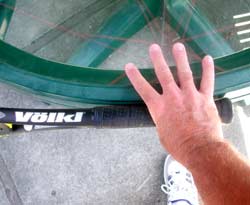 |
Under what circumstances would I use a topspin backhand? Usually when I'm exchanging backhands with my opponent, crosscourt to crosscourt, backhand to backhand. This crosscourt exchange can often be a sequence of chip against chip, but my intent is to swing heavily against the ball, and drive deep and crosscourt while at the same time playing consistently and not going really for a winner.
First things first. The classic backhand grip places the knuckle of the first finger squarely on top of the handle. When holding the racquet in this manner, my palm lies flat on top of the racquet, and it feels as if I am sweeping dust off a table if I pass my hand in this position out toward the ball on the backhand side. More on the swing later, but throughout the pictures note the positioning of my wrist and look for this grip which will be obvious at contact.
Turning and Preparing
From the ready position my first move, suddenly, quickly, yet at the same time with precision, is to adjust to the backhand grip and immediately turn my shoulders.
Note in the second photo how my left leg has turned out and is accepting my body weight, as my right leg goes slack and prepares to move. Unweighting, I have turned and unweighted the right leg which prepares me equally well to either start running on the right leg or to step forward to meet the ball on this same right leg. Preparation is key. Early, compact, hands away from the body, and racquet face square. I am doing my best Rod Laver imitation, and so far so good.
In the third photo I have turned further. My stance is squaring to the ball, and I am readying to step into the swing. Carefully notice the position of my head and shoulders. Though fully turned, I am still exactly facing the ball. When working in the gym to improve your tennis conditioning, never overlook the importance of good flexibility in the neck and shoulders in order turn this much sideways and still watch the ball.
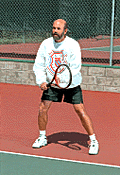 |
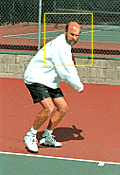 |
Finishing with the Step and Swing
Note my position in the first photo below. I am set, I am on time, I am moving my weight forward to begin the swing. Note the shoulders, held level, and again, the hand is away from the body, and not at all tucked to my belt. A good phrase to recall in this position is, "knees and elbows equally bent" and from here I am literally ready and soon will explode into the hit.
In the second photo I have just met the ball. Note my knuckles - and though hard to see - the position of my palm over the handle is identical to the closeup of the grip. I have held my head still during the contact and balanced my weight down and against the ball. You can see my entire shoe is on the ground, and this is a "grounded hit" (maybe that's why they used to call them groundies).
The classic finish is up and away, the arm is extended and the elbow and knee have straightened. My left arm remains back to keep me balanced and relatively sideways. I can hit this shot again and again in a crosscourt rally.
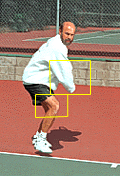 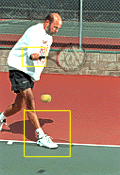 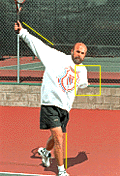 |
Tips to Remember
To develop the crosscourt topspin backhand remember these key tips:
- Early shoulder turn
- Hand away from the body
- Knees and elbows bent
- Finish up and out
Turning and Preparing
From the ready position my first move, suddenly, quickly, yet at the same time with precision, is to adjust to the backhand grip and immediately turn my shoulders.
Note in the second photo how my left leg has turned out and is accepting my body weight, as my right leg goes slack and prepares to move. Unweighting, I have turned and unweighted the right leg which prepares me equally well to either start running on the right leg or to step forward to meet the ball on this same right leg. Preparation is key. Early, compact, hands away from the body, and racquet face square. I am doing my best Rod Laver imitation, and so far so good.
  |
In the third photo I have turned further. My stance is squaring to the ball, and I am readying to step into the swing. Carefully notice the position of my head and shoulders. Though fully turned, I am still exactly facing the ball. When working in the gym to improve your tennis conditioning, never overlook the importance of good flexibility in the neck and shoulders in order turn this much sideways and still watch the ball.
Finishing with the Step and Swing
Note my position in the first photo below. I am set, I am on time, I am moving my weight forward to begin the swing. Note the shoulders, held level, and again, the hand is away from the body, and not at all tucked to my belt. A good phrase to recall in this position is, "knees and elbows equally bent" and from here I am literally ready and soon will explode into the hit.
In the second photo I have just met the ball. Note my knuckles - and though hard to see - the position of my palm over the handle is identical to the closeup of the grip. I have held my head still during the contact and balanced my weight down and against the ball. You can see my entire shoe is on the ground, and this is a "grounded hit" (maybe that's why they used to call them groundies).
   |
The classic finish is up and away, the arm is extended and the elbow and knee have straightened. My left arm remains back to keep me balanced and relatively sideways. I can hit this shot again and again in a crosscourt rally.
Tips to Remember
To develop the crosscourt topspin backhand remember these key tips:
- Early shoulder turn
- Hand away from the body
- Knees and elbows bent
- Finish up and out
![]()
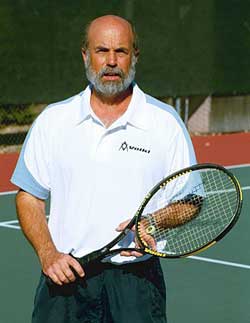 Corky Cramer, TennisONE contributing editor, is beginning a new series of articles from America's Great Teaching Pros. He is the Director of Tennis at the Montecito Heights Health and Racquet Club in Santa Rosa, California.
Corky Cramer, TennisONE contributing editor, is beginning a new series of articles from America's Great Teaching Pros. He is the Director of Tennis at the Montecito Heights Health and Racquet Club in Santa Rosa, California.
As one of the top coaches in Canadian history, he developed over 50 players who won national titles, and coached over a dozen Davis Cup and Fed Cup players. A 25 year USPTA member, Corky is also a board member for The Advanced Tennis Research Project ( www.AdvancedTennis.com ).
